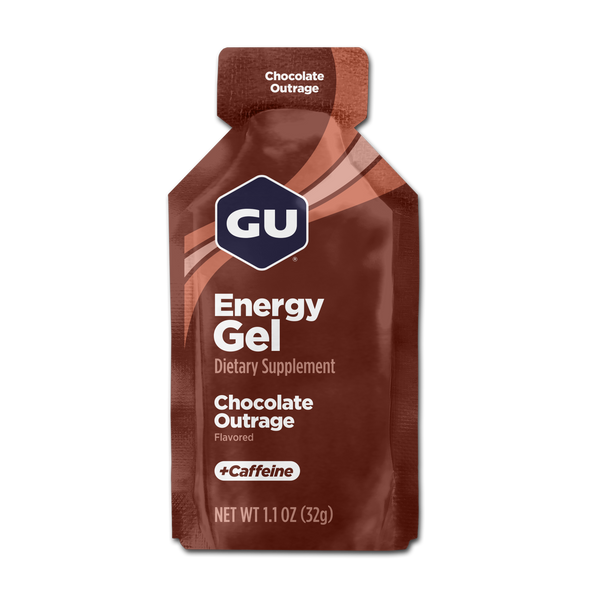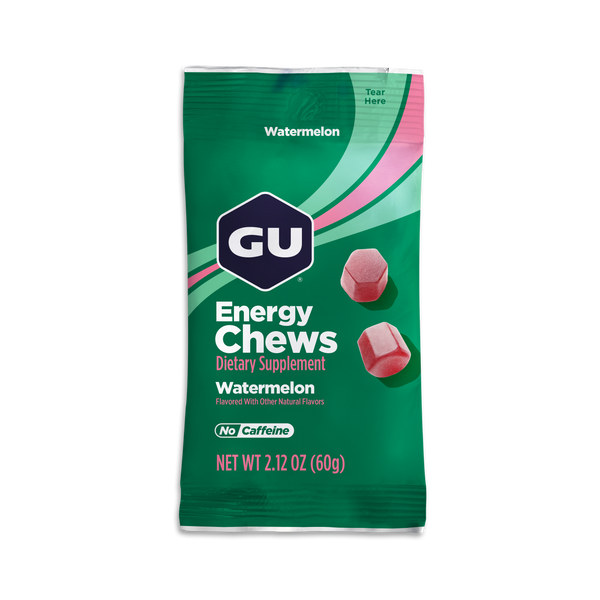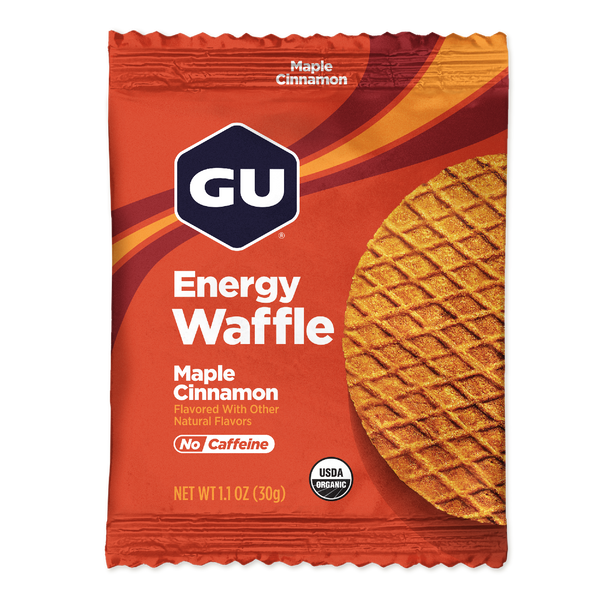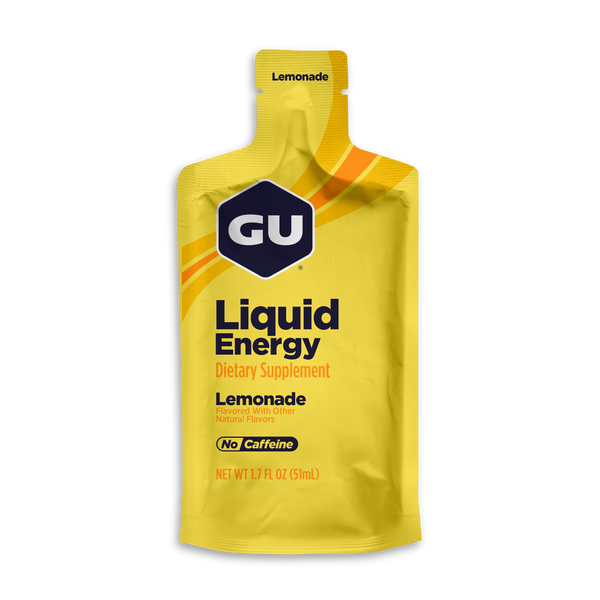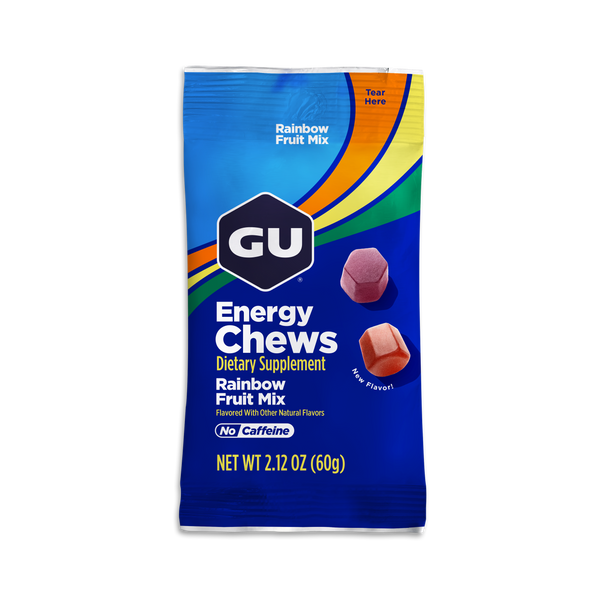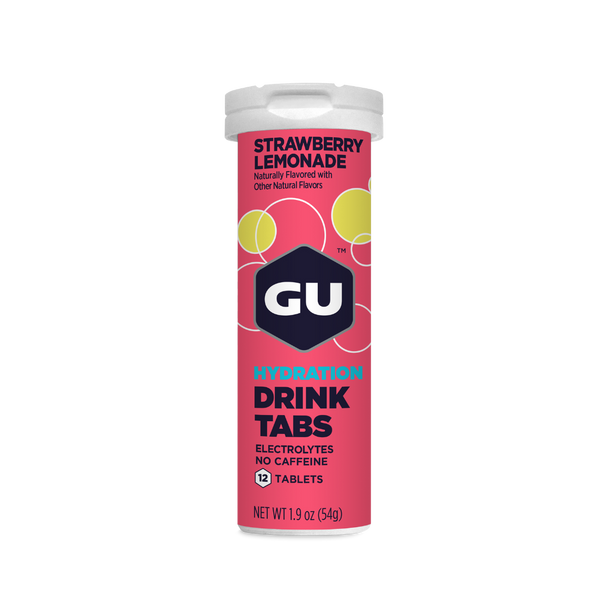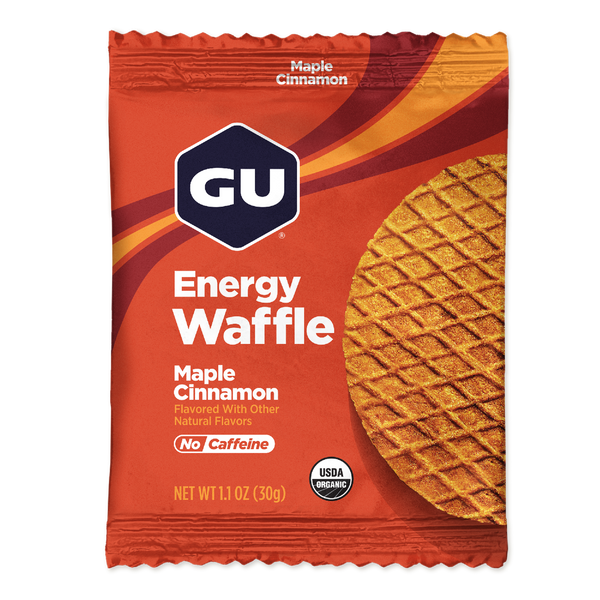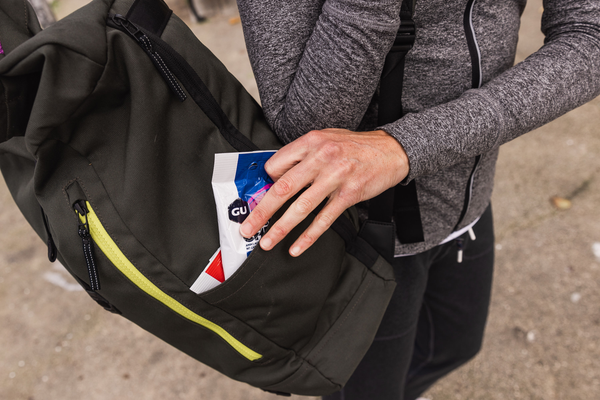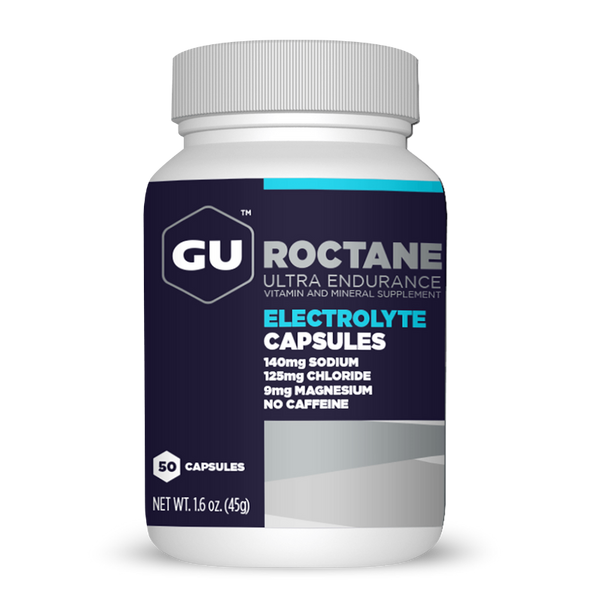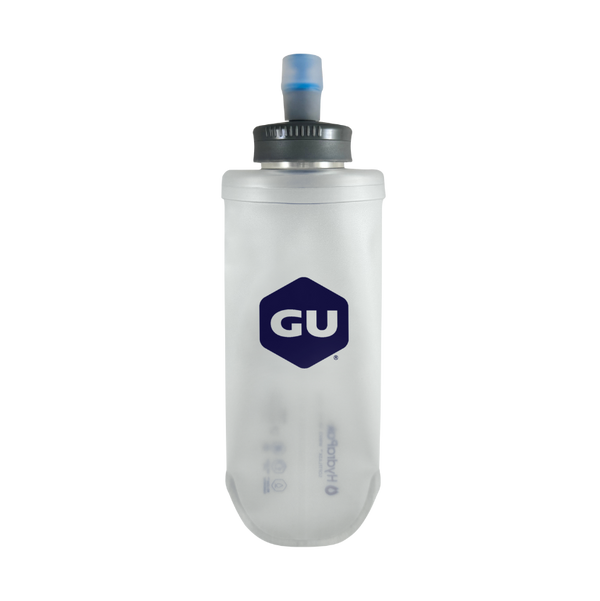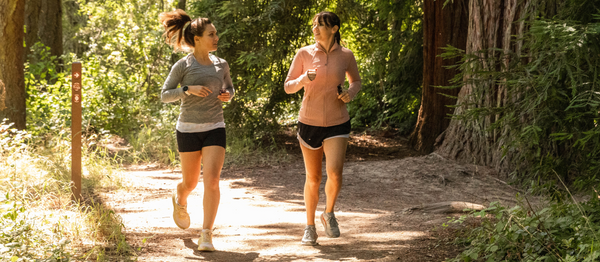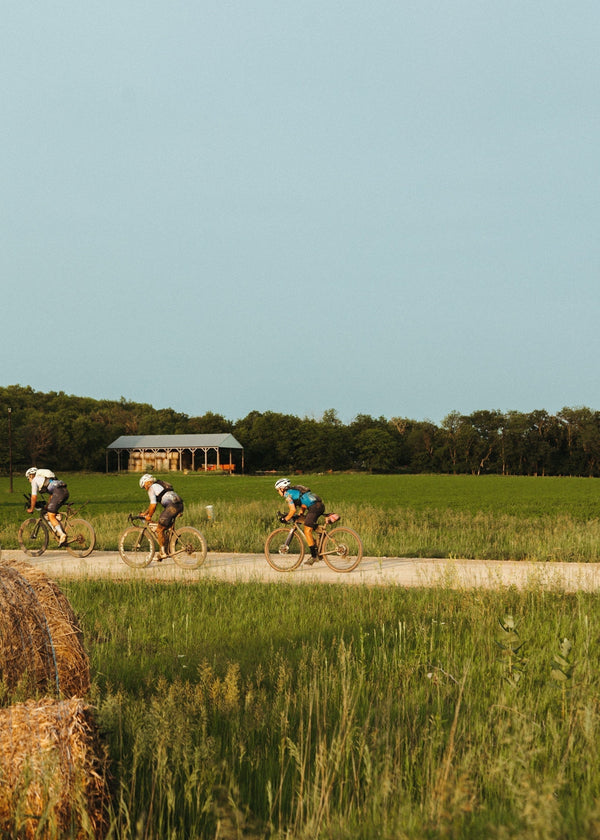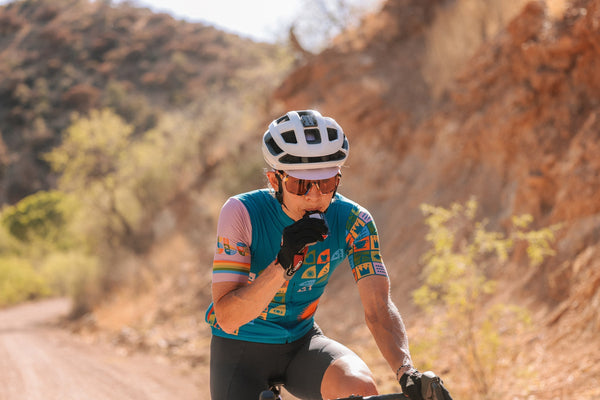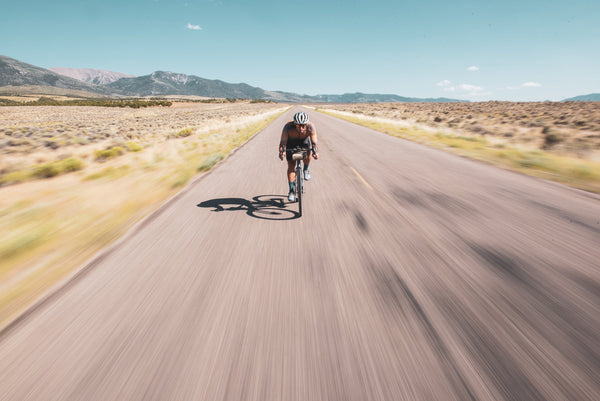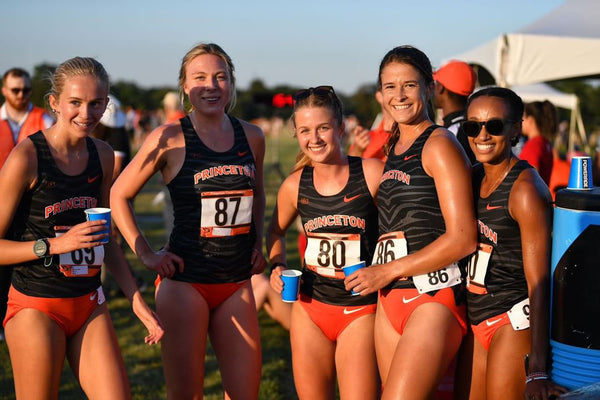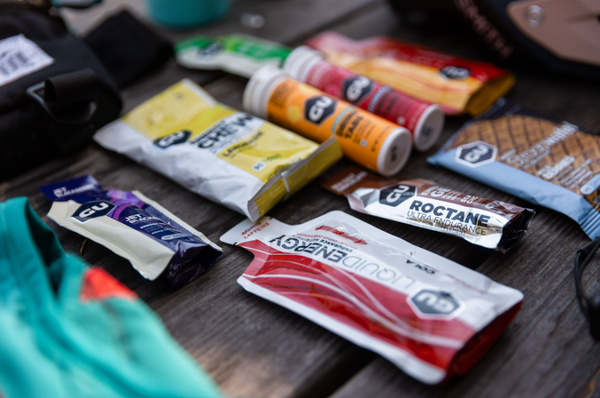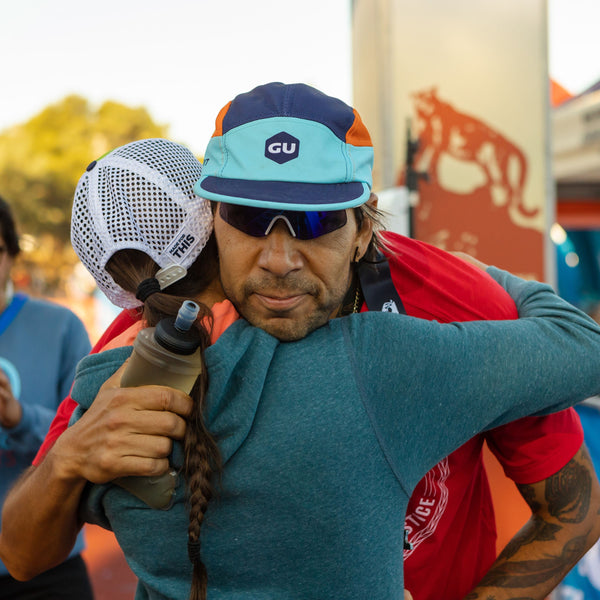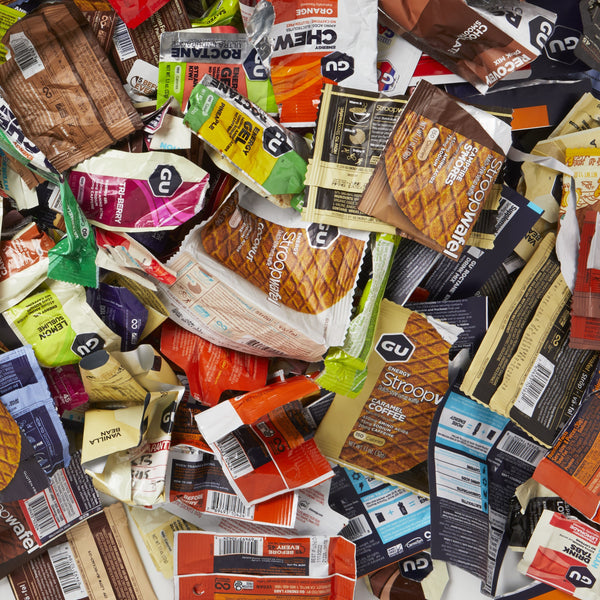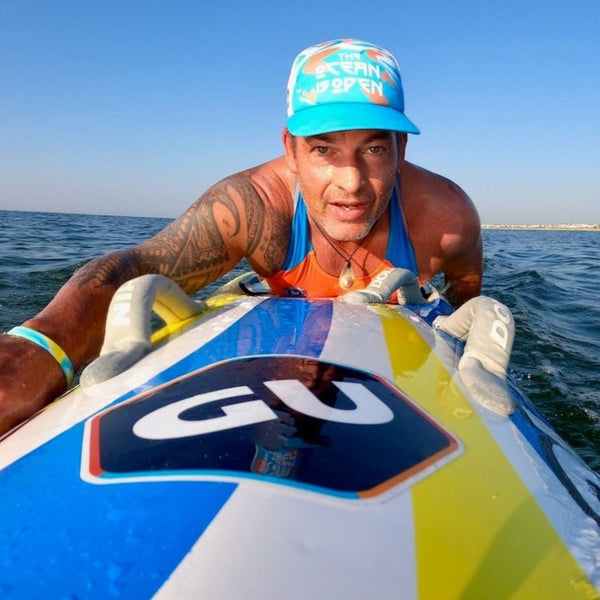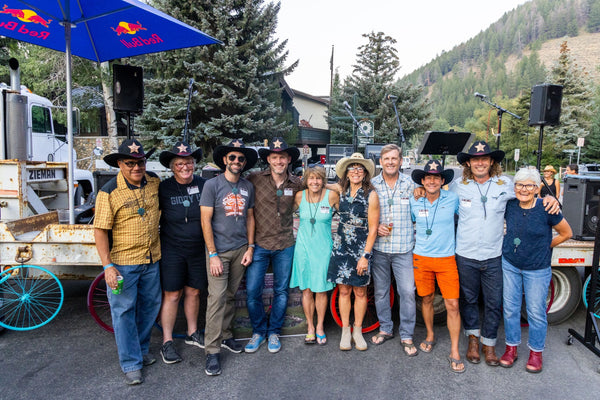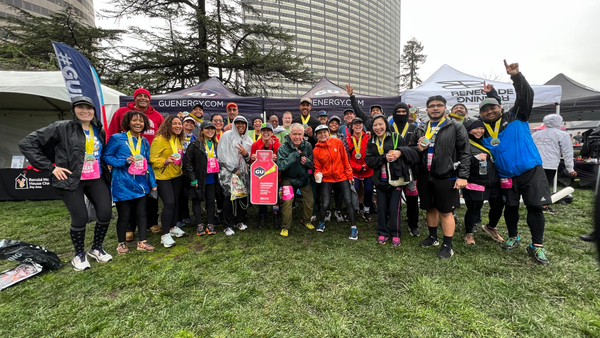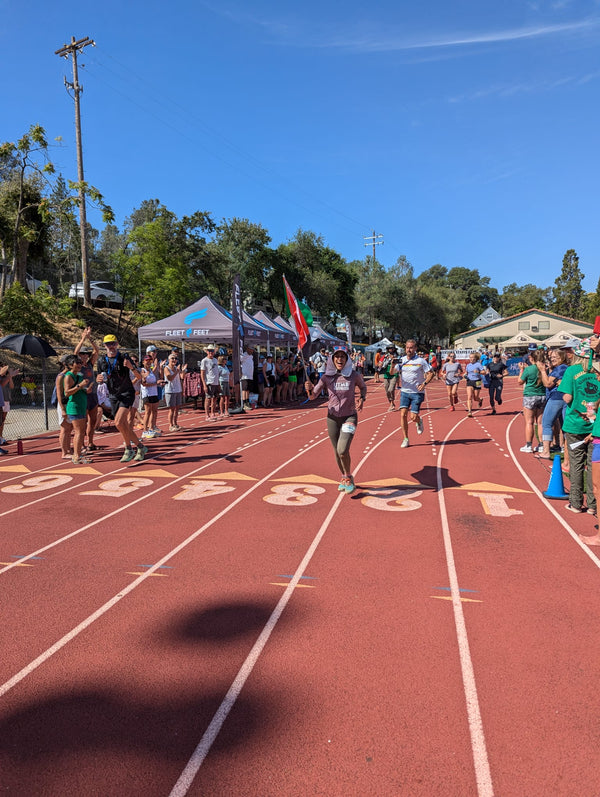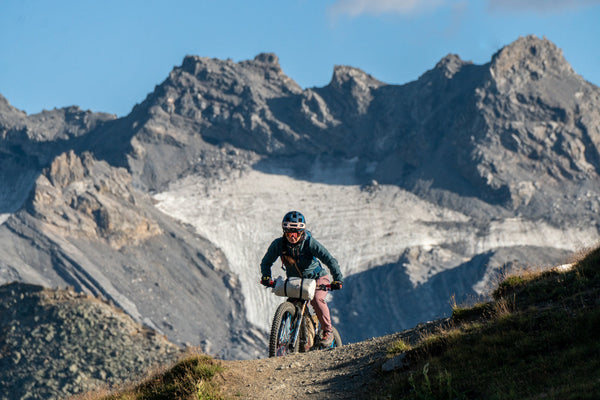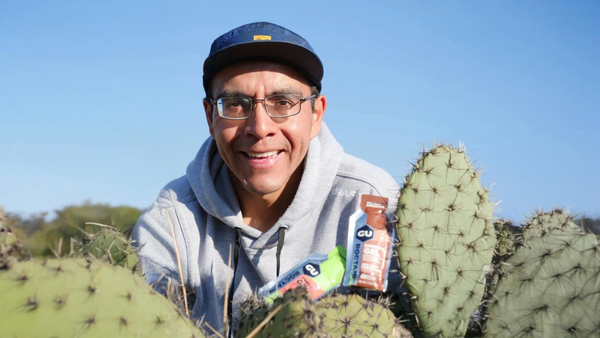Hearts thumping, lungs burning with each breath, moving methodically and slowly, we made our way to the top of Ojos del Salado, ascending over 5,600 feet from high camp. If you’ve ever wondered what it’s like to climb to the dizzying heights of 22,615 vertical feet, let us be the first to tell you it’s no walk in the park. At that altitude the thin air contains only about 45 percent of the oxygen found at sea level, making even the simplest of tasks a challenge. Moving by the light of our headlamps, we had set off just before 4 am with no idea what the day held in store or how it would unfold. We had planned to take 12 hours to reach the summit and descend back to camp. By the time we saw our tent again, nearly 18 hours had passed. The following is a tale of best laid plans and unanticipated outcomes.

In December, GU’s Sports Nutritionist (@roxymtngirl) and VP of Innovation, Research and Development (@runboulet) set out to climb the highest volcano in the world in less than half the amount of time typically required. Most climbers take 10-13 days to reach the summit of Ojos del Salado (22,615 ft/6,893 m), but Roxanne and Magda’s goal was to summit in only five days by using a strict training and pre-acclimatization protocol. Learn more about their pre-departure preparations here.
Read on for Roxanne’s recap of the project.

Ready to GU! Our food nearly outweighed our gear.
Pre-Departure Testing Results
Body Composition and Performance: After six weeks of aggressive Mountain Athlete training and hypoxia exposure using Hypoxico tents, our follow-up DEXA scans, which comprehensively measure body composition, revealed some impressive results. Both Magda and I improved our bone density, lean mass, and muscular balance between limbs. We dropped body fat in nearly equal exchange for lean muscle tissue, decreasing overall percent body fat by almost five percent each. Training and nutrition clearly played a role here, and the thousands of weighted step ups likely helped even out muscular imbalances between left and right legs, which was evident for both of us in our preliminary tests. Improvements in bone density were probably a result of resistance training and twice-weekly plyometric work. We were thrilled by the changes!

Lean Machines: We each replaced five pounds of fat mass with lean muscle in 6 weeks.
VO2max and metabolic efficiency values remained relatively unchanged after the six-week period. These results were not altogether surprising, considering we did not train specifically to improve these numbers, and were already training at a high aerobic level before the project. The main difference in our project-specific workout routine was the amount of vertical and pack-weighted training we incorporated. Increasing our overall training volume, we ended up logging 2-3 hours per day on average, split between morning and evening sessions.
Sample Workouts:
Monday
AM:
- 800x weighted (25 lbs) step-ups on 18” box
- 2-mile run
- 800x weighted (25 lbs) step-ups on 18” box
- 2-mile run
- 400x weighted (25 lbs) step-ups on 18” box
- 1-mile run
PM:
- 8 rounds pushup/pull-up circuit
- 4 rounds core/low back strength circuit
- Stretch and foam roll
Friday
AM:
- 2-hour weighted (25 lbs) uphill hiking
PM:
- 10 rounds leg blasters (lower body plyometric intervals) w/ 30s rest
- 6 rounds calf raise intervals w/ 30s rest
- 4 rounds core/low back-strength circuit
InsideTracker Biomarker Testing: Follow up blood tests revealed improved Vitamin D and serum ferritin levels (iron storage protein, important for red blood cell production and oxygen transport). Both Magda and I supplemented daily with GU Magnesium Plus Capsules (a new product scheduled to launch this year, which delivers 2000 IU Vitamin D3 along with Magnesium, Vitamin K, and Zinc), in addition to an iron supplement. Levels of Vitamin D and ferritin were low previously but reached optimal values upon re-testing. Supplementation appeared to have worked in our favor. Finally, both of us increased our hemoglobin values over the six-week period, which is a key biomarker for high altitude acclimatization.
Heart Rate Variability:
Daily testing using the HRV4Training app showed that recovery took a hit over the course of training and hypoxia exposure. Our HRV numbers had been great before we started the project, fell abruptly the initial week of sleeping in hypoxia tents, and gradually declined thereafter, never reaching pre-training values. I noticed a general sense of fatigue and training staleness over time, the worst occurring in the final week of preparation. It’s likely that sleeping in simulated altitudes over 10,000 feet every night for four weeks hindered full overnight recovery from the twice-daily training sessions. It would be interesting to compare HRV and recovery numbers with identical training minus hypoxia exposure. On the mountain, HRV continued to be impacted, with mediocre values similar to what we had seen during the training period.

Trip Report
Day 0-1:
We traveled over 28 hours, taking 3 flights to get from Berkeley, CA to Copiapó, a small town in Northern Chile. We arrived the next morning where our guide Blaine Horner and a 4×4 pickup truck that we dubbed “The GU Rover,” awaited us. We spent a few hours in Copiapó purchasing supplies (gasoline, cooking fuel, and drinking water to last the entire trip) and headed east four hours to Laguna Santa Rosa. The road to Laguna Santa Rosa is remote and climbs quickly to over 10,000 feet elevation from sea level. There are no services beyond Copiapó.
We set up camp at Laguna Santa Rosa and made a quick dinner before settling in to our tent for the night. Sleeping at 12,500 feet did not cause any signs or symptoms of altitude sickness. (We determined our oxygen saturation via pulse oximetry and completed Acute Mountain Sickness Questionnaires each morning and night.) Our campsite was located in the middle of a vast salt flat, and we were the only people there!

Exploring Laguna Santa Rosa (12,500 ft).
GALLERY
Day 2:
We awoke to a warm, sunny day and enjoyed a leisurely breakfast before continuing our drive two hours further east to Laguna Verde. At over 14,000 feet elevation, Laguna Verde appears suddenly as a shimmering, turquoise oasis amidst the infinite brown desert. It’s beautiful, and a welcome sight for the weary traveler after the moonscape of Laguna Santa Rosa. We established our base camp next to a sandy bluff by the water. After dinner, our team strolled around the salty shoreline and spoke with a few other climbers who were staying nearby. Most of them were on 15-18 day itineraries to summit Ojos del Salado, and were openly skeptical of our 5-day ascent schedule.
Day 3:
From our base camp at Laguna Verde, we drove a very rough and rocky 4WD route (catching air more than once!) to Atacama Refugio at 17,000 feet. The rustic camp consists of a shipping container outfitted with a makeshift kitchen and one bunk bed. We came prepared with supplies to hike to Refugio Tejos at 19,000 feet to make a cache for summit day. The cache would allow us to start lighter and pick up supplies (food, water, warmer clothing layers, crampons, and ice axe) both on the way up and the way down. We made the round trip to Refugio Tejos in under 3 hours and felt great. As we descended, a rainbow appeared overhead amidst an otherwise grey and cloudy sky…a good omen, I thought. We drank some Recovery Drink Mix and drove back down to Laguna Verde to sleep.

Magda checking her oxygen saturation after our carry to Refugio Tejos.
Day 4:
We moved camp to Atacama Refugio in the afternoon, once again covering the rocky route to 17,000 feet. We set up our tent, packed our gear for an early summit bid the next morning, and spent the rest of the day relaxing as much as possible. Everything felt like an effort at 17k feet, and I suffered from a mild headache on and off all afternoon. Magda and Blaine both felt good. We had an early dinner of eggs, rice, and avocado and performed a risk assessment and gear check before turning in for bed.
Our alarms were set for 2:30 am, and the weather forecast looked promising for our summit attempt. Based on our estimates, it would be about a 12-hour day ahead.

Day 5: Summit Day!
I didn’t even hear the alarm go off at 2:30 that morning, I was sleeping so deeply. Magda nudged me awake, and I nearly sprang out of my sleeping bag with excitement. I quickly ate the two Stroopwafels and packet of nut butter I had kept warm in my chest pocket overnight, and Blaine fired up a round of hot drinks in our tent vestibule as we got ready. The temperature outside was in the low teens; frigid, but not terrible by any means. We walked out of camp by the light of our headlamps at 3:45 am, 15 minutes ahead of schedule. Everyone seemed to be in good spirits and feeling well.

Sunrise at Refugio Tejos (19,000 ft) with Ojos del Salado in the background.
Two hours later, with the dawn approaching, we arrived at Refugio Tejos, our cache site at 19,000 feet. Our pace right on target, we refilled water bottles, grabbed our summit provisions (Roctane Energy Gels, Roctane Energy Drink Mix, Stroopwafels, and our prototype BCAA Drink Mix), put on additional layers, and continued on our way. We had 3,500 feet left to ascend.
The air was still as we moved up the steeply switchbacking path toward the summit ridge. My legs felt strong, and I kept my heart rate in check using pressure breathing, a technique practiced by mountaineers to increase oxygen delivery at altitude. For the next hour, we worked our way steadily higher. We stopped to rest near some large boulders at around 21,000 feet where I noticed Magda seemed less animated and lively than usual (she even stopped laughing at my hashtag jokes)…still 1,500 vertical feet to go.
We pushed on, but over the next few hours the pace slowed considerably. Blaine discussed technique with Magda, encouraging her to use the “rest step” to conserve energy in her heavy mountaineering boots. I felt great and was eating and drinking consistently at breaks. Behind me, Magda and Blaine worked on technique, but I noticed neither was eating very much.

Blaine and Magda practicing the "rest step" at 21,500 feet.
At 22,000 feet we reached the volcano’s crater rim. By now, we were far behind our projected schedule, but the weather remained clear and was even sunny at times despite being a mere five degrees Fahrenheit. We decided to keep going, with only the final technical climbing section ahead of us. We reached the ropes leading to the summit around 2 pm, almost 10 hours after leaving camp. We donned our climbing harnesses and started up the 50 feet of rock standing between us and the top. Blaine went first, followed by Magda, then me.

The final climb to the summit at over 22,500 feet requires ropes and a harness.
At 2:30 pm on December 20th, the three of us stood atop the highest volcano in the world at 22,615 feet. We exchanged hugs and high fives, snapped several summit photos, and enjoyed celebratory Stroopwafels. For both Blaine and Magda, this elevation was the highest they’d ever been. As we prepared to descend, I couldn’t help but remind myself the summit is only half way. It had taken us much longer than expected to get this far, and now we had to cover the entire distance again. I glanced over at Magda. She was smiling, but I could see the exhaustion on her face. I had never seen her look tired.

We made our way down from the summit slowly. Very slowly. I wondered if we would make it back before dark. I cursed myself for leaving my headlamp cached at Refugio Tejos that morning. Rookie mistake. Minutes turned into hours as we retraced our path back down from the summit. Magda’s legs would give out on occasion, and she crumbled to the ground, exasperated by the lack of control over her own body. It was approaching dusk and we still had a long way to go.
Just as the last light of the day was fading from the horizon, we reached our cache site at 19,000 feet. We picked up our headlamps, gulped down some Recovery Drink Mix, and prepared to make the final push to camp. In the dark, under a nearly moonless sky, we arrived at our tent almost 18 hours after departing that morning. We were exhausted and filthy. Too tired to cook, we crawled into our tent and fell asleep.

Day 6: Back to Civilization
We slept in the next morning and broke down camp for the last time. Everyone felt surprisingly good considering the the previous day’s effort. As we drove the desolate desert road back to Copiapó, we debriefed, shared a few laughs, and watched the mountains fade into the distance.

What Worked (And What Didn’t)
Hypoxico Altitude Training Systems: Overall, the daily exposure to hypoxia in our tents and Endurance Lab chamber seems to have helped us acclimate sufficiently to function at altitudes up to 14,000 feet without issue. On average, we accumulated 10-12 hours per day of hypoxic exposure: 8 hours sleeping in tents and 1-2 hours each of passive exposure and/or exercise in our chamber at work. On the trip, I suffered mild to moderate headaches a couple of times, most noticeably once we got to 17,000 feet. Magda never had a headache and felt great aside from being physically exhausted on summit day. It’s worth noting that our guide, who lives and trains at moderate altitude in Colorado but did not have access to hypoxia training, seemed to suffer from mild altitude sickness on summit day. Despite having extensive mountaineering experience at extreme altitudes (this was his 10th trip above 20,000 feet), Blaine says this was a particularly challenging summit day for him. During our debrief, he recalled having a headache that got progressively worse that day, in addition to poor sleep quality the night before, and mild nausea. All three are symptoms of Acute Mountain Sickness (AMS). He had struggled to eat, probably only consuming a few gels, a serving of Roctane Drink Mix, and a Stroopwafel or two the entire day. He agrees the hypoxia training likely benefited Magda and me.
Rapid Ascent: The five-day rapid ascent protocol worked, enabling us to cut off a significant number of days from a trip that most people wouldn’t consider doing in less than 10 days. Friends of ours who guide for a living are amazed we pulled it off in such a short amount of time. In hindsight, it’s still hard to believe. The feasibility of the rapid ascent option also opens the door to other possibilities…climbing Everest in half the normal amount of time, perhaps?
Training: The training program was a success. We built muscle (5 lbs), decreased body fat (5-6 lbs), and improved our bone density. Not bad for six weeks!
Supplementation: Our supplementation plan, including Vitamin D and Iron, helped to correct sub-optimal biomarker levels before the trip. Inspired partially by this project was the development of Roctane Magnesium Plus Capsules, which we created to help correct micronutrient deficiencies common among athletes.
We also supplemented with BCAAs, Recovery Drink Mix, and Roctane products during training as well as on the mountain. The products are lightweight, portable, and kept me charging hard all day on summit day. In all, I consumed 3 servings of Roctane Drink Mix, 6-8 Roctane Energy Gels, 2 Stroopwafels, and 2 servings of Recovery Drink Mix over 18 hours. It’s the best performance I’ve ever had above 20,000 feet.
Our guide said the BCAA Drink Mix (in development) and GU Hydration Tabs encouraged him to drink more throughout the entire trip, and claims it’s the best hydrated he’s ever been on the mountain. An interesting twist on Hydration Tabs he showed us was to drop them in hot water…we loved it! BCAAs were key for all of us on this trip, providing muscle-protecting essential amino acids to support muscle repair and decrease breakdown.

Our guide Blaine enjoying some muscle-protecting BCAAs.

We field tested a prototype BCAA drink.
Our final concoction, created specifically for this project, was something we are currently dubbing “Mountain Coffee.” It’s a ready to mix hot breakfast drink with coffee, protein, and a sports performance ingredient blend designed to enhance endurance performance. We think it’s amazing…maybe you will too.


Gear

Hoka One One Tor Ultra Hi hiking boots: Magda and I used these lightweight, waterproof boots for acclimatization hikes and thought they were great. They fit perfectly right out of the box and never caused either of us any blisters or hot spots.

Suunto Spartan Sport Wrist HR Baro watches (Stealth model): These wrist-sized computers are quite remarkable in their capabilities. We used the barometer feature while in mountaineering mode to track altitude and vertical speed during our ascent. The wrist-based heart rate sensor gives you feedback during training as well as overnight, providing information about sleep quality and duration. I was even able to program in our GPS routes for the trip ahead of time, which made me feel better knowing we wouldn’t wander off the mountain in the event of a whiteout! The only problem we encountered was battery life, which, given the length of our summit day, was not surprising. A fantastic watch by all means.
Mountain Hardwear Trango 4 tent, sleeping bags, and Nilas jackets: The Trango 4 is darn-near bomb proof if you ask me! These tents are a staple for high altitude expeditions around the world for a reason. With the three of us in it, ours felt incredibly spacious and had a ton of built-in storage pockets, plus roomy vestibules in the front and back. My negative 40-degree Ghost sleeping bag, although some might consider it overkill, kept me toasty and warm. I tend to sleep cold, so the -40 was the perfect choice for this trip. Magda and I also had matching Nilas down jackets that were packable and lightweight but incredibly warm. They also make a great pillow!

What Didn’t Work
Fueling: It became evident early in the day that neither Magda nor Blaine were taking in sufficient calories, which is a common struggle at high altitude. Magda recalls, “I had a difficult time accessing my food from my backpack. In ultras, I have direct food and drink access on me from a hydration vest, and because my food was inside my backpack and we took breaks on the hour, I did not eat as frequently or as much as I should have when we stopped. The lesson I learned was that instead of expecting to fuel the way I do in ultras, which is by feeding and drinking frequently, I should have practiced being able to eat more once an hour, just like we were going to execute on the mountain. I also should have stashed fuel in my jacket pockets for easy access.”
Gear/Skills Training: Despite being incredibly fit and a world-class endurance athlete, Magda’s mountaineering skills were not adequately practiced prior to the trip, nor did she get many opportunities to wear her boots, which is why we think she was so fatigued by the effort on summit day. It’s possible that the unfamiliar boots and movement techniques impacted her gait to the point of inefficiency, and over the course of several hours this inefficient pattern wore her down. Another possibility is that the extreme altitude affected her muscles’ metabolic regulation, resulting in reduced contractility and force production (as suggested in this article).
What We Learned
As a team, we agreed that the rapid ascent protocol using Hypoxico Altitude Training Systems had positive acclimatization results. It does not, however, replace actual high-altitude mountaineering experience. To that end, it’s imperative to practice in your gear, train efficient movement techniques, and develop breathing techniques for altitude as much as possible. Training to achieve the appropriate fitness level is important, but must be as specific as possible to prepare for the demands of the target event. Fueling consistently and adequately is also key.
Based on our HRV trends, it’s possible that chronic hypoxia exposure may have negatively impacted recovery from training. However, while metrics such as HRV and oxygen saturation can be useful indicators of recovery or acclimatization, they should be interpreted with caution. For example, my oxygen saturation numbers leading up to summit day were abysmal, but I still performed my best when it mattered most.
Conclusions: The Endurance Lab supports the use of pre-acclimatization protocols using hypoxic tents and chambers for those diligent enough to adhere to a strict schedule, provided they possess sufficient fitness and experience to successfully complete the event in the first place. Such a strategy could be appropriate for sea level-residing athletes preparing for high altitude races, climbs, or expeditions. From our experience, this method speeds up the acclimatization process and makes it more tolerable once arriving at high altitude.

We were fortunate to partner with:
@hypoxico, @hrv4training, @uphill_athlete, @mountainhardwear, @hokaoneone, @suunto, @superfeet, and @insidetracker for this GU Endurance Lab project! Thank you all for your support.

